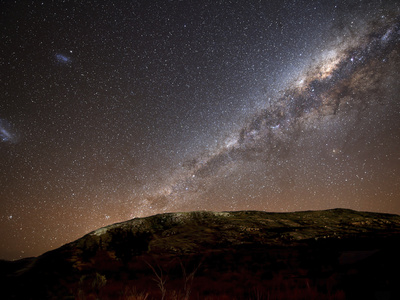The Milky Way -- Our Galactic Home
Go outside on any clear night and look up at the night sky. Every star
you can see with your eyes belongs to the stellar community we live in
known as the Milky Way galaxy--a flattened spiral structure over 100,000
light years across. Because we are located within the Milky Way galaxy
(30,000 light years from its center) we see most of it as a white
glowing band stretching across the sky (see map) -- The Milky Way.

Click Here for Information or to Buy this Print
We know the Milky Way galaxy is made up of over 200,000 million
stars of which our Sun is just one. We also know the Universe contains
over 100,000 million galaxies. That's an astonishing number of stars. It
has been calculated that there are more stars in the Universe than
grains of sand on every beach on Earth! Truly mind boggling.
Make a special effort to view the Milky Way one moonless night from a
very dark location far from the light and air pollution that surrounds
modern cities. The sight of the Milky Way as it stretches from horizon
to horizon is the most spectacular sight you will ever see with your
eyes, and yet it is experienced by so few people. Make the effort and
you will long treasure the moment.
Elsewhere in the Sky...
Look for the brilliant white light of Venus very low in the western sky
at dusk. Soon after sunset on August 30 Venus will form a pretty pair
with the thin crescent Moon. The remaining bright planets are visible in
pre-dawn skies. By the end of the month the gas giants Jupiter and
Saturn will rise around midnight.
Use a good pair of binoculars or a telescope to view Comet LINEAR (S4)
in early August. The comet is located low in the western sky
and with a bit of luck may even display a short tail. Happy comet
hunting!
Related Links:
Related Books:


